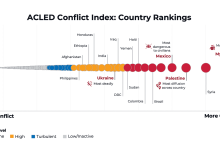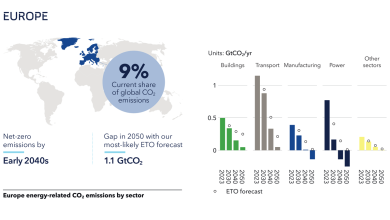Romania Choked with Toxic Dust
Air pollution continues to pose significant health risks in Europe, causing chronic diseases and premature deaths, according to the European Environment Agency (EEA) analysis ‘Air Quality in Europe 2022’. About 96% of the European Union (EU) urban population is still exposed to fine particulate matter (PM2.5) concentrations above the WHO guideline of 5 µg/m3 of air. Air pollution also harms biodiversity and damages agricultural crops and forests, causing major economic losses. These are worrying data that should spur governments to take faster action to reduce air pollution.
Analysis by the European Parliament’s environmental experts shows that at least 238,000 people died prematurely in the EU due to exposure to PM2.5 pollution above the WHO’s target of 5 µg/m3 in 2020. Nitrogen dioxide pollution has led to 49,000 deaths and ozone exposure to 24,000 early deaths in the EU. Although air quality has improved in recent years, pollution is still the biggest risk to environmental health in Europe and more ambitious measures are needed to meet the standards set by the World Health Organisation (WHO), the EEA points out in its report ‘Air Quality in Europe 2022’.
Air Quality Directive to be amended
The European Commission proposed in October 2022 the revision of the Ambient Air Quality Directive, in order to impose stricter thresholds for air pollution. The European Commission wants to reduce the amount of fine particulate matter PM2.5 from 25 μg/cubic metre to 10 μg and force governments to compensate people whose health is affected by pollution. The aim of the new proposals is to improve air quality by 2030, leading to estimated gross annual financial benefits of between EUR 42 and EUR 121 billion, all at an annual cost of less than EUR 6 billion.
On the other hand, with the revision of European legislation, the right for people whose health is affected by air pollution to be entitled to compensation in the event of a breach of EU air quality rules will be introduced, the European Commission proposes. They will also have the right to be represented in court by non-governmental organisations through collective actions for compensation for damages.
The initiatives put forward by the European Commission will now be discussed and voted on by the European Parliament.
45% reduction in premature deaths
From 2005 to 2020, however, the number of early deaths from PM2.5 exposure has decreased by 45% in the EU. If this trend continues, the EU is expected to reach the Zero Pollution Action Plan target of a 55% reduction in premature deaths by 2030.
However, further efforts will be needed to meet the target. At least in Romania, these efforts should be stepped up given that Romanians are among the most exposed EU citizens to toxic dust. For example, two cities in Romania are among the top 1,000 most polluted cities in the world, according to the latest air quality report. These are Otopeni (Ilfov County), ranked 650th, and Ojdula (Covasna County), ranked 462nd, according to the IQAir report published in spring 2022.
In terms of country rankings, Romania ranks 66th with a PM2.5 concentration of 15.3, and Bucharest ranks 58th with a concentration of 14.9.
Also highlighting the seriousness of the situation in Romania, a recent report by the Ecopolis Centre for Sustainable Policies showed that pupils in 27 schools in the capital are exposed daily to concentrations well above the normal limit of particulate matter – PM10 and PM2.5. The Centre monitored these schools for two years and the report contained data from the National Air Quality Monitoring Network and the aerlive.ro platform.
Between October and December 2021, aerlive.ro sensors had daily average PM2.5 concentrations up to five times higher than the annual limit value.
For the first four months of 2022, the majority of aerlive.ro stations had high values, mostly above the limit. The average number of exceedances above the limit values indicates that PM2.5 pollution is widespread in Bucharest.
Biodiversity loss, significant damage
Returning to the analysis ‘Air Quality in Europe 2022’, the document points out that air pollution damages terrestrial and aquatic ecosystems.
In 2020, harmful levels of nitrogen deposition were observed in 75% of the total EU ecosystem area. This represents a 12% reduction since 2005, while the EU’s zero pollution action plan target is to reach a 25% reduction by 2030.
According to the analysis, 59% of woodland and 6% of agricultural land was exposed to harmful levels of ground-level ozone in Europe in 2020. Economic losses due to the impact of ground-level ozone on wheat production totalled around EUR 1.4 billion in 35 European countries in 2019, with the largest losses in France, Germany, Poland, and Turkey.
EU Member States must fully and properly implement the environmental rules imposed by European directives without delay because non-compliance costs EUR 55 billion a year, EU Environment Commissioner Virginijus Sinkevičius warned recently when presenting the third report of the Environment Committee on the implementation of the European executive’s environmental policy.
Heating of buildings, main source of pollution
The main source of particulate matter pollution in Europe is the combustion of fuels in the residential, commercial, and institutional sectors, the EEA analysis shows. These emissions are mainly related to the combustion of solid fuels for heating buildings. In 2020, the sector was responsible for 44% of PM10 emissions and 58% of PM2.5 emissions. Other significant sources of these pollutants include industry, road transport and agriculture. Agriculture was also responsible for the vast majority (94%) of ammonia emissions and more than half (56%) of methane emissions. For nitrogen oxides, the main sources were road transport (37%), agriculture (19%) and industry (15%). Overall, emissions of all key air pollutants in the EU continued to decline in 2020. This trend has continued since 2005, despite considerable growth in EU gross domestic product (GDP) over the same period, the EEA analysis also notes.
Romania referred to the CJEU
In December 2021, the European Commission referred Romania to the Court of Justice of the European Union (CJEU) for failing to comply with EU rules on combating industrial pollution and failing to adopt an air pollution control programme. Although a year has passed, the authorities in Bucharest have still not solved this problem. In the first case, Romania has not ensured the operation of industrial installations based on a valid permit under the Industrial Emissions Directive (Directive 2010/75/EU) to prevent or reduce pollution. In the second case, Romania has not adopted its first national air pollution control programme under Directive (EU) 2016/2284 on the reduction of national emissions of certain atmospheric pollutants (‘NEC Directive’).
The Industrial Emissions Directive establishes rules designed to prevent and reduce harmful industrial emissions to air, water and soil and to prevent the generation of waste. Under the Directive, industrial installations must have permits to operate, and without a permit, compliance with emission limit values cannot be verified and risks to the environment and human health cannot be effectively prevented.
Regarding the NEC Directive, Member States are required to develop, adopt, and implement national air pollution control programmes. These programmes must include measures to achieve levels of air quality that do not give rise to significant negative impacts on or risks to human health and the environment.
The Directive sets emission reduction commitments for five air pollutants (sulphur dioxide, nitrogen oxides, non-methane volatile organic compounds (NMVOCs), ammonia and fine particulate matter – PM2.5). Member States are required to report annually on these pollutants, and Romania should have submitted its first national air pollution control programme to the European Commission by April 1, 2019, but the programme has not yet been adopted.
The Ministry of Environment, Water and Forests (MMAP) estimates that this will happen in the first quarter of 2023.
Amendment of Law 278/2013 awaits in Parliament
Under the threat of an imminent financial penalty, the Executive adopted in June 2022 a draft law to amend and supplement Law No 278/2013 on industrial emissions, but so far, the draft has not passed Parliament, so its provisions do not apply for the time being.
The act introduces penalties depending on the seriousness of the offence, in line with European practice. Thus, exemptions from some provisions of Ordinance No 2/2001 on the legal regime of administrative offenses have been introduced, which no longer allow the payment of half fines, or the suspension of operation of the complementary administrative penalty consisting of the suspension of the operation of installations, until the date of compliance, both for operation without an integrated environmental permit and for non-compliance with the provisions of the integrated environmental permit. Thus, “the adoption of this draft law by Parliament would entail the closure of the infringement proceedings opened by the European Commission against Romania in this area,” the Ministry of Environment, Water and Forests stated in the explanatory memorandum.
The new draft law introduces penalties ranging from RON 50,000 to RON 80,000 for failure to comply with the provisions on the operation and control of waste incineration and co-incineration plants by a natural person who does not have the necessary training and competence.
In the current version of the law, this offence is punishable by a fine between RON 15,000 and RON 30,000. At the same time, for failure to comply with the provisions on the operation without an integrated environmental permit of any installation in the field of integrated pollution prevention and control, the penalty is increased to an amount between RON 150,000 and RON 500,000, whereas currently this penalty is between RON 50,000 and RON 100,000.
New criminal penalties have also been introduced. It will be punishable by imprisonment from six months to three years or a criminal fine to operate without an integrated environmental permit/environmental authorisation or to continue the activity after the complementary administrative penalty of suspension of the activity has been ordered.
Also punishable by imprisonment for a term of three months to one year or a fine is the operation under conditions where the installation endangers human, animal or plant life or health, the operation after substantial modifications of any combustion plant or installations, waste incineration plant or waste co-incineration plant without an integrated environmental permit/environmental authorisation including the operating conditions corresponding to the modifications.
“In conclusion, the legislative act is justified by the need to ensure a legal framework that allows and respects the proper application of the provisions of Directive 2010/75/EU, so that the provisions of Article 79 of that Directive, regarding the establishment of effective, proportionate and dissuasive penalties, are applied,” the Ministry of Environment states.







